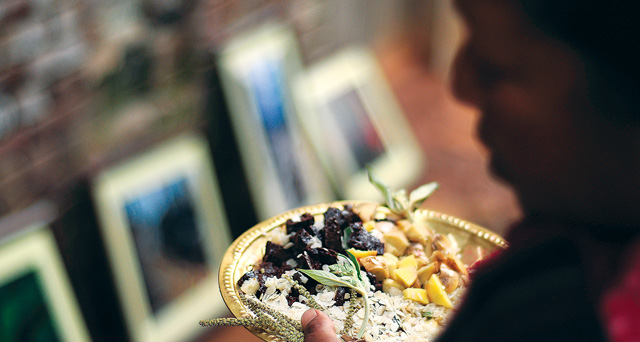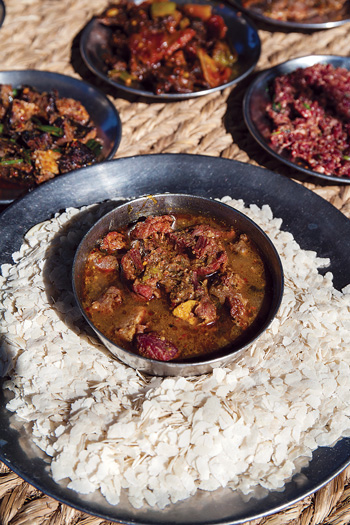It’s when the shopping begins that you know that the festival is now really and truly on. It’s not the shopping for clothes, decorations, and such that I’m talking about, that’s secondary. It’s foodstuff that’s on top of the agenda for any festival to acquire that true festive spirit.

Take the month gone by, for example. January 14 was the day of Maghe Sankranti, an annual festival observed to celebrate the end of the coldest period of winter, and to welcome the warmer days ahead. The day before, you would have found the vegetable markets crowded with shoppers buying a particular tuber, the yam (tarool), without which the Maghe Sankranti festival is incomplete. This tarool, now, it is a nourishing food, has a hard outer covering, and comes in all sizes. What’s more, the meat comes in a range of colors, too, either white or yellow or pink or purple.
 Cooked the right way, it makes for a delicious dish. Just eating boiled, and then cooled, pieces with some salt tastes pretty good; marinated in spices, and fried crispy golden brown, they are scrumptious; tarool is also used to make pakodas, kheer, and curry (with green peas). Now, tarool is not all of the festive food of Maghe Sankranti. As is usual for almost all festivals, there’s a range of different dishes, and so you also have ghyao (clarified butter) and chaku (hardened molasses) and til-ko-laddoo (small balls of molasses and sesame seeds). The first two, particularly, warm you up considerably and thus are ideal for winter.
Cooked the right way, it makes for a delicious dish. Just eating boiled, and then cooled, pieces with some salt tastes pretty good; marinated in spices, and fried crispy golden brown, they are scrumptious; tarool is also used to make pakodas, kheer, and curry (with green peas). Now, tarool is not all of the festive food of Maghe Sankranti. As is usual for almost all festivals, there’s a range of different dishes, and so you also have ghyao (clarified butter) and chaku (hardened molasses) and til-ko-laddoo (small balls of molasses and sesame seeds). The first two, particularly, warm you up considerably and thus are ideal for winter.
Well now, let’s see a few other examples of Nepal’s festive fare. There’s a saying that goes like this: “Dashain aayo, khub khaunla, piunla, ramailo garunla” (Dashain is here, we’ll eat, drink, and be merry). Yes, the biggest Hindu festival of the country, the ten-day-long Dashain (Sept 21-30, this year), is a time of gorging on some really tasty fare. Meat is at the top of the list, and duck is the exceptional addition to the more common mutton, buffalo, and chicken. You won’t find many places selling duck meat through the year, but during Dashain, if you are in Kathmandu, you’ll see a lot of ducks being sold around Sundhara, near the Dharahara tower (or, the remnants of, after the notorious 2015 quake).
Dashain calls for animal sacrifices in temples of Goddess Durga; goats, chicken, ducks, and pigeons being the ones getting the short end of the stick (actually, a clean, and hopefully humane, khukuri chop on their necks), and what you have then is plenty of meat in many homes. If it’s a goat (the most preferred animal), you get to try out all sorts of cooking styles and recipes when preparing everything from the toes to the ears (well, not the toes, actually, since they are discarded). The sacrifice day falls on the eighth day (Maha Asthami) of this great festival, but that’s not to say that the preceding seven days are bereft of meat. Throughout the ten days of Dashain, families enjoy veritable feasts every day.
 Many households (especially of the Newar community) don’t eat rice (the normal daily staple of all Nepalis) during Dashain, substituting it with chiura (beaten rice) instead. Spicy meat curry and chiura make for a great combination, and the gastronomic pleasure is further heightened due to the addition of kauli tarkari (fresh cauliflower curry) and mula ko achar (pickle of radish, potatoes, and green peas). Dessert is almost always dahi (yogurt), and this, too goes very well with chiura.
Many households (especially of the Newar community) don’t eat rice (the normal daily staple of all Nepalis) during Dashain, substituting it with chiura (beaten rice) instead. Spicy meat curry and chiura make for a great combination, and the gastronomic pleasure is further heightened due to the addition of kauli tarkari (fresh cauliflower curry) and mula ko achar (pickle of radish, potatoes, and green peas). Dessert is almost always dahi (yogurt), and this, too goes very well with chiura.
The second most important Hindu festival, Tihar (Oct 18-21), is when people make a special circular bread called selroti in their homes. This culinary art calls for deft skill and experience. Finely beaten rice flour dough with added sugar is collected in a thin muslin cloth, and poured expertly through a hole in a circular shape onto a large and shallow pan containing ghyao (clarified butter) that has been heated to a high boiling point. The cook (usually the lady of the house) uses two thin sticks to concoct the dough into as perfect a circle as possible, and of a particular size, leaving a large hole in the middle. Both sides of the sizzling dough are fried, until the selroti turns a robust brown.
This crispy bread is tasty and wholesome, and an essential offering by sisters to their brothers during Bhai Tika (the last day of Tihar), along with dry fruit, fruits, sweetmeats, and so on. Selrotis are also offered to those who come to play deusi and bhayilo (revelers who go from house to house singing songs and dancing during Tihar). Tihar is almost immediately followed by the most important festival of the Terai (plains), that is, Chaath Parwa (October 25), when Surya, the Sun god, is worshipped by fasting, taking purifying baths in rivers, and laying out ritual offerings on the banks. The most important offering is a sweet, crusty bread called thekuwa, which like other ritual food, is as tasty as it is sacred.
While specific types of food are part of most festivals, food as such holds greater importance in some. Like Teej (August 8), for example. It’s a three-day festival observed by Hindu women (mostly Chettri women, also of other castes; mostly married, but also unmarried), during which a 24-hour fast is the norm. As preparation for the fasting day, women go to their paternal homes the night before to enjoy the dar khane ritual, during which there is much dancing and singing, as well as consumption of a wide variety of rich delicacies. On the last day of Teej, the women eat karkalo ko tarkari (curry made of lotus leaves) and pure food cooked in ghyao (clarified butter).
Well, as is obvious, there appears to have been much thought given by the ancients to keeping spirits alive and rejuvenated during the many festivals of Nepal, some of which are pretty demanding. Not only those requiring strict fasting, but also those like Indra Jatra (Oct 6, Kathmandu), Rato Machindranath Jatra (May15-July 15, Lalitpur), and Bisket Jatra (Apr 9-16, Bhaktapur), where participants are required to lend a strong hand for pulling the massive wooden chariots of different gods through the streets and alleys of the historic cities.
Before concluding, mention must also be made of the Dhaan Ropain (paddy plantation day, June 29, Kathmandu Valley) and Yomari Punhi (Jan 15, Kathmandu Valley). The former is the joyous occasion of planting new paddy saplings, during the course of which, farmers eat a lot of dahi (curd) and chiura (beaten rice), accompanied by generous glassfuls of thwon (rice beer). The latter is to celebrate the origin, in Panauti, of the delicacy known as yomari (stupa-shaped steamed dumpling consisting of an external covering of rice flour stuffed with molasses).
So, you see, this article could go on and on about the place of food in Nepal’s numerous festivals, but suffice it to say that just as the country is known as a land of festivals, so too it is known for its wide variety of delicious fare.










